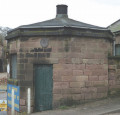(S/E) From St Andrew's Church in Swanwick village (A), walk East-South-East down the road, The Green, (B6016) following the signs to the Conference Centre. Take the first turning to the right (South-East) onto Hayes Lane and walk on crossing the road to go up to the entrance to the Hayes Conference Centre.
(1) Here turn left (East) at the footpath sign to follow the track up the hill. Passing Hilltop Mink Farm on the right, continue until the track turns sharply.
(2) Go straight ahead (South-East) over the stile to follow the sign to Golden Valley. Follow the footpath straight ahead down the hillside. Go under the railway line (B). After 100 yards, right under the 2nd underpass, walk on and cross the railway line. Immediately after the railway line take the left (South) fork up through the trees.
Past the Brittain Pit turn right at the junction of paths (taking Amber Valley Route 4). After a few yards turn left to go down the hill to cross two stiles in the valley. BEWARE of the barbed wire on the stiles. Enter the field (C) and follow the path up left (South) along the hedge to reach the Coach Road at the former Toll Bar cottages.
(3) Turn right along the Coach Road (D), until you reach the white house. At the junction by the white house go straight ahead to pass the Police Headquarters (E) on the left. Notice it says it is OK for authorised vehicles and pedestrians to go there.
(4) Turn right (North-West) and walk down the road to Derby Road at Butterley. On your left you will see the site of Butterley Works and the Gatehouse (F). Cross the road with care. Pass the Midland Railway Centre on your left (G).
(5) After crossing beneath the railway bridge, cross the track (with care) and take the marked footpath (East). Walk up the fields (do NOT take the path to the right) with Butterley Grange (G) on your left and railway to the right. Continue ahead on the footpath and continue around Grange Farm and on up the hill (H) towards The Hayes Conference Centre. (2)
Passing the Conference Centre on your left you come back to Hilltop Mink Farm. Cross back over the stile on your left and turn right to return down the track to the entrance of Hayes Conference Centre and back to St Andrew's Church in Swanwick village. (S/E)













